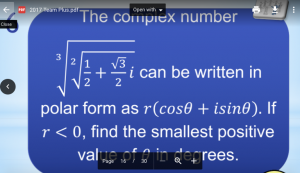I am thrilled to be one of the 9 people who will be representing our school in the South East Asian Mathematics Competition, in March this year. This is the gateway to the prestigious World Mathematics Championship, and more over, SEAMC is being hosted by UWCSEA this year – hence, it is crucial for me to work towards doing well. This means that I steer away from the logo designing aspect of creativity (which has been handed over to the marketing team of UWC for approval), towards more rigorous mathematics.
The SEAMC format has changed a lot and has come to encompass a lot more creativity and collaboration, which syncs well with the UWCSEA skills and qualities. No longer will be only have the team round and individual round – we will also be having to create 3-dimensional models to stimulate mathematical concepts, and posters and videos to illustrate to same. We have been designated teams of three already as it is important that we are comfortable with the people we are working with. Training has gotten a lot more serious, and the style and difficulty of the questions which we are asked to tackle, at our training sessions are a lot more challenging. However, it is gratifying to be in a room with 8 other individuals, just as interested in this competition as me. This has created a more energetic environment than what was there in the first segment of training which consisted of 30 odd students cramped into a single room.
Example of an interesting SEAMC question, which aims to develop skills and understanding of complex numbers:
The rigour of this activity is evident from the selection process used to choose the students who would be attending this competition. It consisted of scores over all mathematics competitions that are conducted be it the UKMT (United Kingdom Mathematical Trust), AMC(American Mathematics Competition), CEMC (Centre of Education in Mathematics and Computing, University of Waterloo) etc. Thankfully, I have taken part in all these competitions, since grade 9. The selection process also consisted of 6 tests conducted by our school teachers and student leaders, attendance points and an Oxbridge style interview. This is my opinion was the most challenging part – as we would be called for individual interviews with teachers who would question us, and hand us a sum to work through. Given that the questions are real ones that have been used, they were very challenging and it was important to think our way through the process, to give the teachers insight into the way in which our mind was working. While this is important, as in SEAMC we will be working in groups, this was not something I would normally associate with mathematics.
However, this email made it all worth it and I look forward to the training sessions as well as the competition to gain a greater understanding of new concepts, and also to form new friendships with the people I work with.
Learning outcomes highlighted:
- increased their awareness of their own strengths and areas for growth
- undertaken new challenges
- worked collaboratively with others
- shown perseverance and commitment in their activities
- developed new skills




Leave a Reply